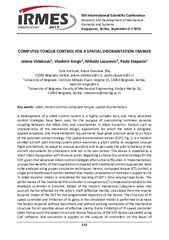Приказ основних података о документу
Computed torque control for a spatial disorientation trainer
| dc.creator | Vidaković, Jelena | |
| dc.creator | Kvrgić, Vladimir | |
| dc.creator | Lazarević, Mihailo | |
| dc.creator | Stepanić, Pavle | |
| dc.date.accessioned | 2023-01-31T06:57:26Z | |
| dc.date.available | 2023-01-31T06:57:26Z | |
| dc.date.issued | 2019 | |
| dc.identifier.isbn | 978‐86‐6335‐061‐8 | |
| dc.identifier.uri | https://machinery.mas.bg.ac.rs/handle/123456789/4099 | |
| dc.description.abstract | A development of a robot control system is a highly complex task, and many advanced control strategies have been used for the purpose of overcoming nonlinear dynamic coupling between the robot links and uncertainties in robot dynamics. Factors such as characteristics of the mechanical design, applications for which the robot is designed, applied actuators, and implementation requirements have great practical value to a choice of the potential control strategy. The spatial disorientation trainer (SDT), Fig. 1, is a modern combat aircraft pilot training system which examines a pilot's ability to recognize unusual flight orientations, to adapt to unusual positions and to persuade the pilot to believe in the aircraft instruments for orientation, and not in his own senses. This device is modeled as a 4DoF robot manipulator with revolute joints. Regarding a choice of a control strategy for the SDT, given that advanced robot control strategies often entail difficulties in implementation, prospective benefits of their application compared with traditional control approaches need to be analyzed using proper simulation techniques. Herein, computed torque (CT) control, a single joint feedforward control method that implies cancelation of nonlinear coupled terms in robot dynamic model, is considered for tracking of SDT’s time‐varying trajectories. The performance of the traditional PID controller is compared to CT compensation added to the feedback controller in Simulink. Model of the motor’s mechanical subsystem takes into account inertia reflected on the rotor’s shaft (effective inertia), calculated from the inverse dynamic model of the SDT for the programmed trajectory of the device. The structure of PI speed controller and limitation of its gains in the simulation model is performed to achieve the fastest response without overshoots and without exciting resonances of the mechanical structure for all possible values of effective inertia. Gains limitation of PI speed controller takes into account the lowest structural natural frequency of the SDT device calculated using CAE software, and saturation is applied at the outputs of controllers on the bases of maximum torques that chosen motors can achieve. Within CT compensation, the error in load torque calculation from the dynamic model is assumed to be 5%. The reference speed values are given as a series of discrete values obtained from the trajectory planner. In Fig. 2a, trajectory tracking for axes k=1, 2.. 4 using two considered types of controllers are presented. Reference values are given in blue, the controlled process variables obtained by PI speed controller and by CT compensation added to PI speed controller are given in red and green, respectively, and the obtained errors are given in Fig. 2b in the same colors. The addition of the CT compensator to the PI speed feedback controller achieved considerable improvement in trajectory tracking in simulation example, for a typical SDT motion. The simulation results are significant regarding the choice of a control method for the SDT, but are also useful regarding the design of the mechanical structure of the manipulator, and consequently the appropriate choice of motors. | sr |
| dc.language.iso | en | sr |
| dc.publisher | Kragujevac: Faculty of Engineering, University of Kragujevac, Department for Mechanical Constructions and Mechanization, | sr |
| dc.relation | info:eu-repo/grantAgreement/MESTD/Technological Development (TD or TR)/35023/RS// | sr |
| dc.relation | info:eu-repo/grantAgreement/MESTD/Technological Development (TD or TR)/35006/RS// | sr |
| dc.rights | openAccess | sr |
| dc.rights.uri | https://creativecommons.org/share-your-work/public-domain/cc0/ | |
| dc.source | Book of Abstracts for the 9th International Scientific Conference [on] Research and Development of Mechanical Elements and Systems, IRMES 2019, 08-10. September, 2022. | sr |
| dc.subject | robot | sr |
| dc.subject | motion control | sr |
| dc.subject | computed torque | sr |
| dc.subject | spatial disorientation | sr |
| dc.title | Computed torque control for a spatial disorientation trainer | sr |
| dc.type | conferenceObject | sr |
| dc.rights.license | CC0 | sr |
| dc.citation.epage | 173 | |
| dc.citation.rank | M34 | |
| dc.citation.spage | 172 | |
| dc.identifier.fulltext | http://machinery.mas.bg.ac.rs/bitstream/id/9602/Vidakovic_IRMES_2019.pdf | |
| dc.identifier.rcub | https://hdl.handle.net/21.15107/rcub_machinery_4099 | |
| dc.type.version | publishedVersion | sr |


